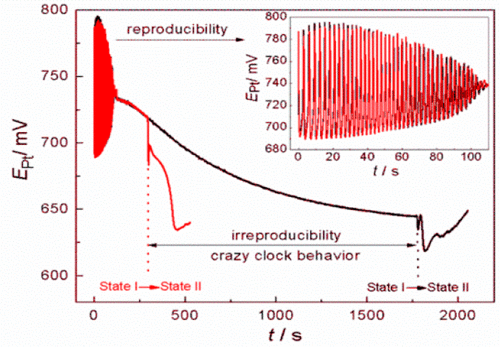当前位置:
X-MOL 学术
›
J. Phys. Chem. A
›
论文详情
Our official English website, www.x-mol.net, welcomes your feedback! (Note: you will need to create a separate account there.)
Transition from Low to High Iodide and Iodine Concentration States in the Briggs–Rauscher Reaction: Evidence on Crazy Clock Behavior
The Journal of Physical Chemistry A ( IF 2.9 ) Pub Date : 2018-01-05 00:00:00 , DOI: 10.1021/acs.jpca.7b11774 Maja C. Pagnacco 1 , Jelena P. Maksimović 1 , Nebojša I. Potkonjak 2 , Bojan Đ. Božić 3 , Attila K. Horváth 4
The Journal of Physical Chemistry A ( IF 2.9 ) Pub Date : 2018-01-05 00:00:00 , DOI: 10.1021/acs.jpca.7b11774 Maja C. Pagnacco 1 , Jelena P. Maksimović 1 , Nebojša I. Potkonjak 2 , Bojan Đ. Božić 3 , Attila K. Horváth 4
Affiliation

|
The Briggs–Rauscher reaction containing malonic acid may undergo a sudden transition from low (state I) to high iodide and iodine (state II) concentration states after a well-defined and strongly reproducible oscillatory period. This study clearly shows that even though the time-dependent behavior of the oscillatory state is reproducible, the time lag necessary for the appearance of the state I to state II transition after the system leaves the oscillatory state becomes irreproducible for an individual kinetic run. This crazy clock behavior of the state I to state II transition is identified by repeated experiments in which stirring rate is taken as a control parameter and all other parameters such as initial conditions, temperature, vessel surface, and the age of solution were kept constant. Surprisingly, a better stirring condition does not make the transition reproducible; it simply does not allow the transition to happen at all. The proposed mechanism, additional explanations, and proposals for this irreproducibility of state I to state II transition have been presented. Considering the fact that the number of crazy clock reactions is only a few, this study may contribute to a better understanding of fundaments of this phenomenon.
中文翻译:

Briggs-Rauscher反应中低碘和高碘浓度状态的转变:有关疯狂时钟行为的证据
经过明确定义且可高度重现的振荡周期后,含有丙二酸的Briggs-Rauscher反应可能会突然从低(状态I)变为高碘和碘(状态II)浓度状态。这项研究清楚地表明,即使振荡状态的时间依赖性行为是可重现的,但对于系统而言,从单个振荡运行开始,从系统离开振荡状态到出现状态I到状态II过渡所必需的时间滞后也是不可重现的。状态I到状态II转换的这种疯狂的时钟行为是通过重复实验确定的,其中将搅拌速率作为控制参数,并将所有其他参数(例如初始条件,温度,容器表面和溶液的使用期限)保持恒定。出奇,更好的搅拌条件不能使过渡重现;它根本不允许过渡发生。已经提出了针对I状态向II状态过渡的不可复制性的机制,其他解释和建议。考虑到疯狂的时钟反应的数量很少,这一研究可能有助于更好地理解这种现象的基本原理。
更新日期:2018-01-05
中文翻译:

Briggs-Rauscher反应中低碘和高碘浓度状态的转变:有关疯狂时钟行为的证据
经过明确定义且可高度重现的振荡周期后,含有丙二酸的Briggs-Rauscher反应可能会突然从低(状态I)变为高碘和碘(状态II)浓度状态。这项研究清楚地表明,即使振荡状态的时间依赖性行为是可重现的,但对于系统而言,从单个振荡运行开始,从系统离开振荡状态到出现状态I到状态II过渡所必需的时间滞后也是不可重现的。状态I到状态II转换的这种疯狂的时钟行为是通过重复实验确定的,其中将搅拌速率作为控制参数,并将所有其他参数(例如初始条件,温度,容器表面和溶液的使用期限)保持恒定。出奇,更好的搅拌条件不能使过渡重现;它根本不允许过渡发生。已经提出了针对I状态向II状态过渡的不可复制性的机制,其他解释和建议。考虑到疯狂的时钟反应的数量很少,这一研究可能有助于更好地理解这种现象的基本原理。


























 京公网安备 11010802027423号
京公网安备 11010802027423号